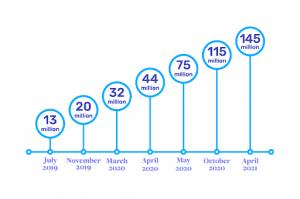With the workplace being such a fast-paced and ever-changing environment, it is becoming more common for people to work remotely from different timezones when compared to the majority of their team.
When working with people in different timezones, there are things that you can do to improve communication and help them feel included.
The right communication will make your team more productive and focused while working remotely in different timezones, whilst the wrong communication will quickly lead to mistakes and setbacks.
Tips for successfully working with team members in different timezones
Here are some tips that will help you communicate with other team members in different timezones.
1. Great team organization is key
The right organization is key to a successful working relationship, as without the correct organization it will be difficult for anyone involved to stay on track.
Make sure that everyone understands their responsibilities and what is expected of them. Organize a meeting with all team members at the beginning of every week to ensure that there are no miscommunications or misunderstandings about expectations.
2. Let virtual processes and project management tools make things simpler
Project management software makes your team organized by allowing everyone to have a shared repository where files can be stored for easy retrieval at any time. Such tools allow you all to work on the same documents together, communicate more effectively, share tasks, track progress, and help resolve queries quickly.
By using this type of tool, it is easier to manage projects in different timezones because every team member has access to the system from anywhere in the world, meaning that no one ever has an excuse not to complete their responsibilities.
It also means that you can collaborate with other team members wherever they are, as it doesn’t matter what timezone they happen to be in.
Further, you can use task management software such as Trello and Asana to track progress and hold each other accountable for tasks that need to be completed. You can also set definite deadlines for each task so everyone is aware of the timeframe within which they need to complete their part.
3. Record meetings for those that can’t make them
For those team members who don’t manage to make meetings (for one reason or another), record them and send out a recording afterward. This ensures that everyone has access to important information even if they weren’t able to attend; and further enables discussions later on where decisions made at the meetings can be talked about and agreed upon.
Make sure to send a summary email immediately after a meeting so those who couldn’t attend can catch up. You could send those emails in bulk by using a simple email marketing service that allows you to send an email to a list of addresses at a time.
Meeting records can also be referenced later on in case there are any queries by those that attended such meetings.

With the number of online meetings ever increasing, ensuring everyone is aware of what was discussed during a meeting is key.
4. Be specific when mentioning dates and times
Be as specific as possible when mentioning times and dates of anything that is happening, especially if you have different timezones being represented within the discussion. Everyone reading your message must know at what time you are referring to.
For example: “can we meet next Tuesday at 10 A.M. your time?” isn’t as good as “can we meet next Tuesday at 10 A.M. EST time?”
Use a simple timezone converter tool to make sure everyone understands the different times you are talking about.
Remember not to mix AM and PM times or use roman numerals, as these can be misunderstood across different languages. This may sound like a small detail but it is important as from experience, it has been the cause of a lot of confusion and unnecessary stress.
5. Ensure everyone is on the same page by verifying agreed upon times
When it’s time for any conference/meeting/call, timezones should be considered and stuck to in order to avoid miscommunications.
If everyone must be present then ensure that the meeting takes place at the time that was agreed. This is especially important when doing business with multiple countries in different regions throughout Asia, Europe and America.
It’s also important to understand the designated work hours for your employees so you are aware of their availability during which times of day they are working. For example, someone living in California may only be able to attend a morning meeting due to having their commitments in the afternoon and evening whereas someone living in Thailand may only be able to attend a late afternoon meeting.
If team members are located in different timezones, divide up work amongst them so they can complete their tasks during their peak times of productivity. This ensures that all the work gets done according to the best time for each individual.
Remember not to put pressure on anyone and ensure that they have enough time to complete what’s expected of them within a timely manner.
6. Make it fair for all team members
Ensure everyone has a fair chance to have their say in a conference/meeting/call by using a ‘conference call mode’ so no one person is drowned out by another individual speaking over them louder.
By doing this, it allows people who may find themselves speaking up more often to do so without having to worry about dominating the conversation, while also allowing others to contribute when they feel comfortable enough to do so. Not only does this make for a fairer discussion but it’s also much easier on the ears.
People that are in the same building/timezone can sometimes gang up together and push for a decision that favors them, which is not good for the well-being of the company. Ensuring that everyone gets a fair share of time and that their opinions are listened to, provides a good level of democracy within the company.
In addition, making use of virtual icebreakers can sometimes liven up a meeting and ensure that the team dynamic is at the level it should be.

7. Value everyone’s time
By verifying details as many times as required before agreeing to anything, it prevents anyone from feeling like they are being taken advantage of or that their time is not important enough.
This applies to all types of meetings, ranging from one-on-one or group meetings to webinars and teleconferences, as well as business emails.
Timezones should also be considered when adding people to different chats; not everyone will be available to show up when you create an impromptu chat.
This also applies to messaging software like Slack; make sure everyone understands what times will be suitable for others by asking if they’re available during certain hours of the day rather than just setting a global standard.
Ensuring that everyone is working during the best times for them by maximizing their productive time can help increase output from team members and prevent any feelings from arising about unfair treatment. This also shows that everyone’s time is valued and the feeling is reciprocated.
In an age where artificial intelligence is quickly taking over many business processes, it’s important to show everyone in your company (both employees and customers) that the human touch isn’t lost.
Showing that you value someone’s time is crucial and can be done in a variety of ways.
In addition to the above points, ensure that if you have an internal website (or intranet) for your employees, where they can get specific information to help them work better, this is updated regularly and shows the latest information that keeps everyone on the same page.
The same applies when it comes to your customer-facing website. Humanizing your website in this digital age can help people get what they want fast. In addition, it can get them to return when they need your product or service in the future.
8. Ask for help when you need it
By asking for help from your team members or co-workers when you need it, not only will they take a load off of your mind but you can also ensure that the work gets done promptly.
If someone is falling behind on their work and a deadline has to be pushed, rather than pushing this responsibility onto one person, try and get help from everyone so nobody feels frustrated by being put under pressure.
Asking for help can benefit all parties as it allows others to see what areas they may have been missing out on. This may encourage them to better plan their time the next time a similar task comes around.
On the flip side, pushing too much responsibility onto one person could lead them to become overwhelmed with the workload and eventually burn out. This isn’t beneficial for them or the company as it can lead to them either quitting out of frustration or simply losing their edge over other candidates.
9. Understand how everyone can contribute
Companies are getting better at understanding different types of intelligence and how they can be used, rather than just placing people into categories like ‘creative,’ ‘technical’ or ‘management.’
Everyone has strengths and weaknesses, but that shouldn’t stop them from utilizing their skills; some people may not have had an opportunity to fully express these abilities within their previous roles for whatever reason.
By pushing employees to give more of themselves, not only will you retain your current staff members but you might also attract new team members who share similar values. Providing employees with opportunities to develop their skill sets can help them become happier within their roles and more fulfilled as individuals.
Offering guidance to employees on how they could improve themselves will help improve your relationship with them because rather than seeing it as a criticism, they will feel that you are concerned about them and their wellbeing.
Giving actionable suggestions allows employees to take responsibility for how they work within the company without feeling judged or targeted.
10. Have a timezone visualization chart.
By using a timezone visualization chart, you can ensure that everybody knows who should be working on what at which times. This will benefit team members in different regions and prevent any issues with people not showing up due to them thinking a meeting was scheduled at a different time.

These visual aids don’t have to be overly complicated or fancy; you could simply print off a monthly calendar of your region and add color-coded annotations to highlight times that should not be scheduled – such as during specific national holidays or when people have taken time off.
11. Be flexible and see your team members as people rather than assets
Finally, being flexible with employees doesn’t just mean treating them well within their role; it is about understanding what makes each person tick and developing a relationship with them so you can approach certain situations more effectively.
By truly understanding the needs of every individual, you will also understand how best to operate your business and how to work around these issues if they do arise.
By viewing people as cogs in a machine, one can often forget that individuals have lives outside of work. If this happens, it can lead to issues when trying to communicate with others due to time differences.
With the future of work being flexible, you need to take responsibility for the way your business operates and ensure that you are equipped with the best tools and systems to work with, rather than placing blame on other people.
If you take ownership of your actions and understand how they affect those around you, this can help strengthen relationships within teams which will ultimately help achieve better results within projects.
Conclusion
People generally want to know that what they do is valued and appreciated. This could be achieved through a variety of methods, including monetary gain, appreciation, or even simply knowing that their opinions matter and that what they have to say is worthwhile.
It is important to consider all team members when making decisions about how the company should operate; if one person feels undervalued, it could spread like wildfire throughout an office environment.
Having people working in different timezones is not ideal; however, it is a reality for many. With the technological advancements available today, it is easier than ever to ensure that everyone can work as efficiently as possible within their timezone and stay up-to-date with what other team members are doing.
By being flexible with employees, ensuring that everybody has equal say in how the company should operate, and developing a relationship with them just as you would a friend, this will help create a much better working environment which will be beneficial to everybody involved.









